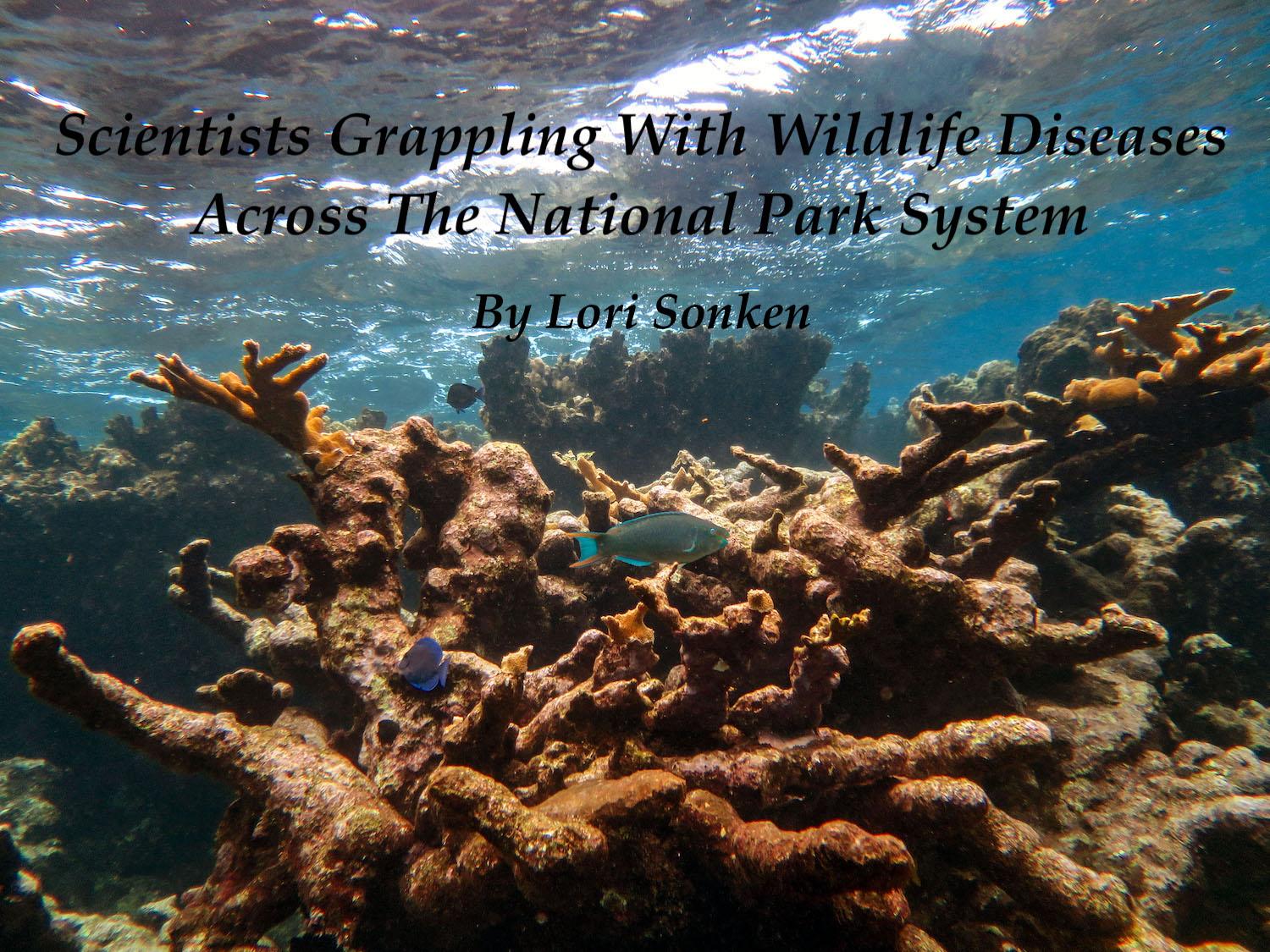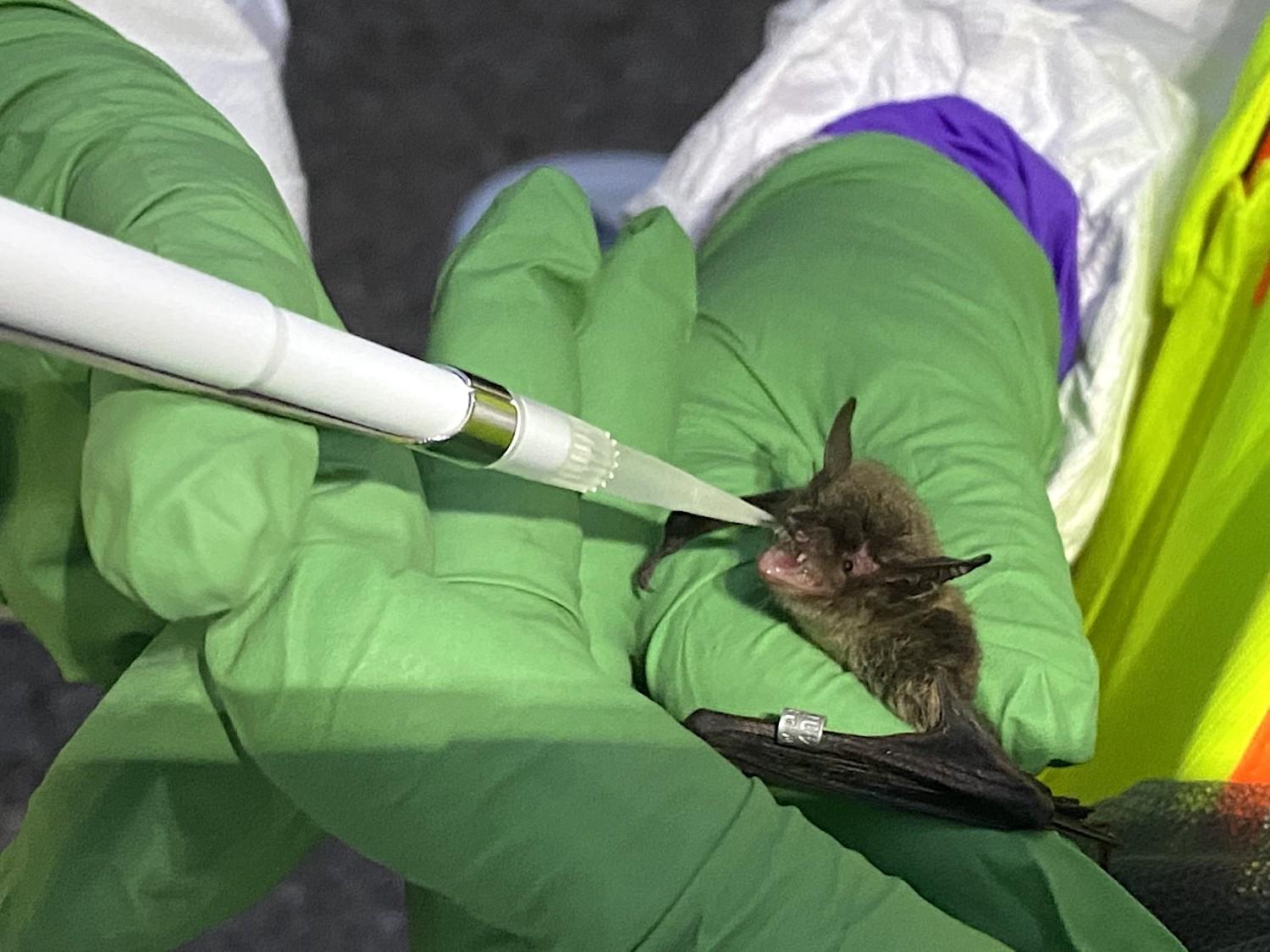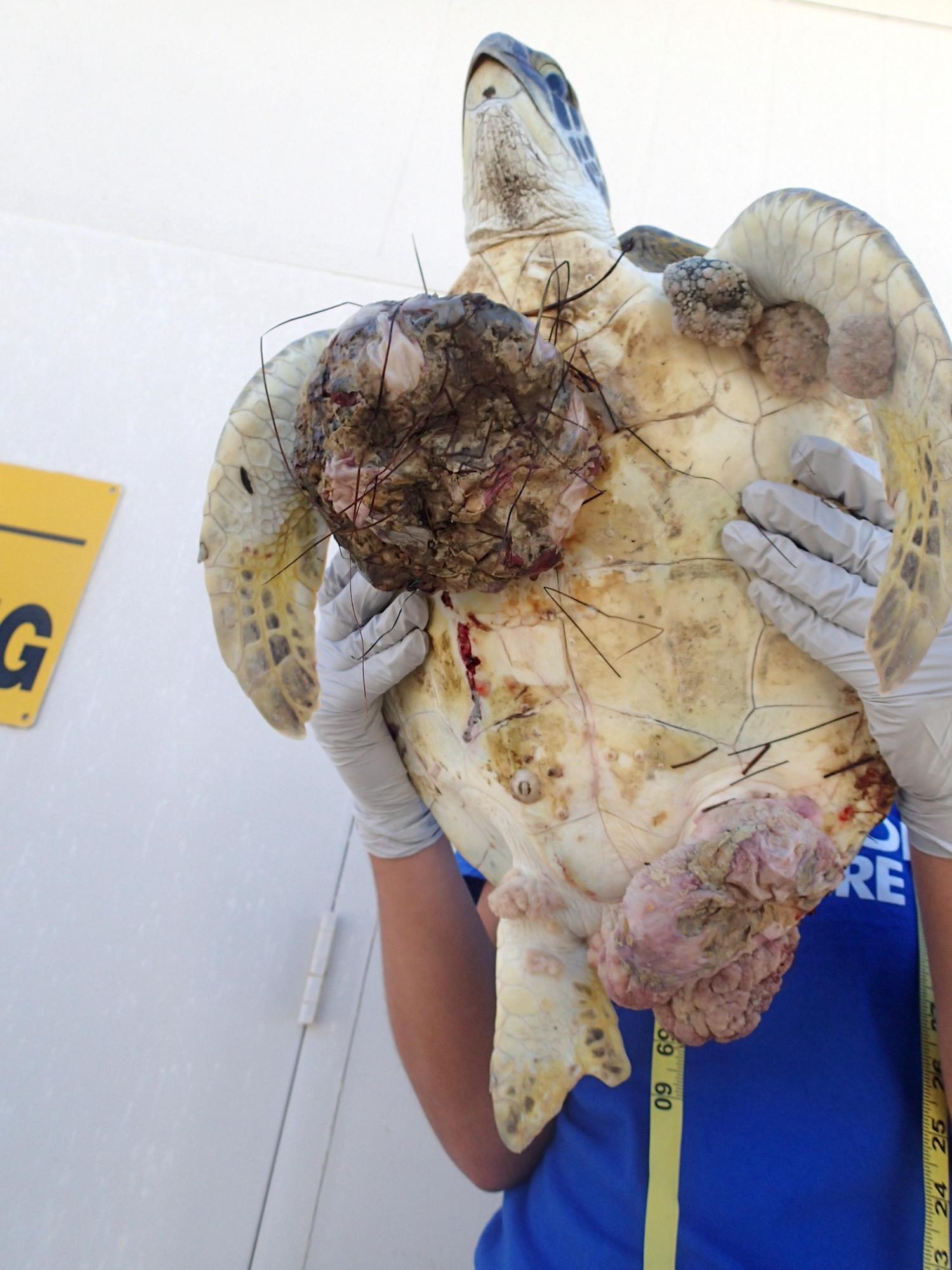
A wave breaking over a degraded reef crest at Buck Island National Monument in St. Croix. Wave-breaking in these habitats relies on reef framework built by the elkhorn coral, Acropora palmata, which is now a threatened species throughout the western Atlantic. Without the structure these corals provide, the ability of reefs to protect coastal communities may be in jeopardy/USGS
Buck Island Reef National Monument draws tens of thousands of tourists annually. Most travel by boats operated by concessioners from St. Croix, Virgin Islands, but some moor their own vessels in the crystal-clear turquoise waters. The island also attracts scientists, like Lauren T. Toth, fascinated by the elkhorn corals growing on the pristine coastal barrier reef in the Caribbean Sea.
A research physical scientist with the U.S. Geological Survey, Toth studies coral reef geology and how reefs grow. Buck Island’s reef is so shallow that “you have to suck in your stomach” while swimming over the coral, she said. Damaged by disease, habitat degradation and other factors, the coral reef at Buck Island is significantly flatter than it once was, and listed as threatened under the Endangered Species Act.
Toth coauthored a peer-reviewed study published in Nature Communications this spring that is the first to quantify how elkhorn coral restoration could mitigate the most extreme impacts of coastal flooding. Restoring the coral reef could reverse projected trajectories of reef erosion and allow the reef to keep pace with expected sea-level rise due to climate change, the study found.
Across the country scientists, like Toth, are using national parks as their laboratories. Aside from coral reef mitigation, they study pressing wildlife health issues, including white-nose syndrome affecting bats; chronic wasting diseases in elk, moose, and deer; sylvatic plague killing prairie dogs, and fibropapillomatosis afflicting endangered sea turtles.
To restore a coral reef, scientist collect small fragments or fully formed colonies of coral and replant them in underwater or land-based coral nurseries. Once the corals reach about 10 centimeters high, they're reattached to the reef piece by piece with cement, zip ties, and nails, according to the National Oceanic and Atmospheric Administration.
Coral reef restoration has the dual benefit of promoting tourism — visitors come to Buck Island to spot the coral while swimming, snorkeling, and scuba diving — and breaking the waves before they pummel the coastline. Given predictions that sea level will rise about 1.5 feet by 2100, healthy reefs can keep waves from wreaking havoc onshore.
Using numbers provided in previous studies by Elisa Bayraktarov and NOAA, Toth’s paper said coral reef restoration at Buck Island would cost from $6.6-$12 million. Whether the National Park Service fully restores Buck Island’s reef at the scale called for in Toth’s study remains to be seen. But the park is developing a coral reef restoration program, she said.
“To me, our study was exciting because it was hopeful. It shows what we can do to turn the decline of reefs around, “ Toth said.
Battling A Bat Disease
Tonie Rocke, a research epidemiologist with the USGS’s Wildlife Health Center, is also encouraged by the work she is doing. Rocke is developing a vaccine to treat bats with white-nose syndrome, a fungal disease that has killed millions of North American bats in about 39 states and two Canadian provinces. More than 90 percent of northern long-eared, little brown, and tri-colored bat populations have been decimated by the disease in the last decade. Due to the high mortality rate, the northern long-eared bat is an endangered species and the tri-colored is proposed for endangered species status under the ESA. The U.S. Senate recently passed legislation that would overturn the U.S. Fish and Wildlife Service’s 2022 decision to designate the northern long-eared bat as endangered, but this change has not been enacted.

Researchers conducted a trial run to monitor the efficacy of a vaccine for white-nose syndrome/USGS
National parks are home to 45 species of bats, keystone species essential to ecosystems. Bats also help control mosquitos, moths, and other insect populations that can damage agriculture.
First discovered in the winter of 2006-2007, white-nose syndrome leaves a white powder on the bats’ muzzles and wings. Bats with the fungal disease have been spotted flying outside on freezing cold winter days. The disease likely came from Europe, although this theory is not certain, said Rocke.
She works in Wisconsin where pre-trials with a vaccine have shown “positive outcomes,” she said. Additional tests are underway in parks in Western states, including at Fort Laramie National Historic Site in Wyoming. In some cases the vaccine is sprayed topically on the bats. As the bats groom themselves, they ingest the medicine.
White nose syndrome has not been found to be transmissible to humans. But visitors to Wind Cave National Park in South Dakota where the fungus affects the bats are asked to decontaminate after touring a cave where the bats reside.
Rocke also helped develop a peanut butter-flavored vaccine bait for prairie dogs to protect them against sylvatic plague brought by fleas. Prairie dogs are the primary food source for the endangered black-footed ferret residing at Badlands and Wind Cave national parks. If parks lose the prairie dog, they will also lose the black-footed ferret.
During initial field trials at several sites, including Wind Cave, vaccinated prairie dogs were more likely to survive plague outbreaks, but scaling up to larger field applications has been difficult. “Production of vaccine baits was too expensive,” said Rocke. Now, Colorado Parks and Wildlife is conducting additional research on the vaccine.

Earlier this year some elk were culled from Wind Cave National Park to reduce the threat of chronic wasting disease/NPS file
It costs about $.50 per bait to administer the vaccine, which works best with a booster, said Rocke. This gets costly when trying to inoculate prairie dogs spread over thousands of acres. Dusting the prairie dogs’ burrows with insecticides is another way to reduce disease outbreaks and using both the vaccine and the insecticide is probably the most effective option, albeit costly.
“We need to reduced costs and then test at a larger scale to determine if the vaccine will be a useful plague management tool,” said Rocke.
Wind Cave National Park also has Chronic Wasting Disease, which is devastating to elk, deer, and moose around the country. Discovered at the park in 1997, the disease affects about a quarter of the elk on the eastern portion of the park, according to the USGS.
The park has removed elk at various times, including this past January, when the backcountry was closed for one month, except on weekends, to allow animals to be taken and tested for CWD. Animal removal is part of a long-range study conducted by the USGS to determine if lower elk density levels correlate with lower CWD prevalence.
“We’re still collecting and analyzing the data to understand the reasons” why the disease occurs at different rates across the park, said Glen A. Sargeant, a research wildlife biologist at the USGS’s Northern Prairie Wildlife Research Center in North Dakota. He suspects there’s an environmental reason responsible for the variability and presence of CWD over short distances.
“For some reason, some animals are more or less exposed to one another or less exposed to environmental contamination,” he said.
Unlike a virus or bacteria, CWD can persist in soils and surfaces for years and is not easy to destroy, Sargeant said. It can take a long time — from 1-3 years — to detect the disease from the time the animal is exposed until it shows clinical signs, which may include weight loss, stumbling, or drooping ears.
Unlike sylvatic plague, which can afflict humans, CWD is not known to be contagious to people. It’s spread in cervids through saliva, urine, blood, feces, animal carcass, and contact with contaminated environments. The disease has been detected in 30 states, two Canadian provinces, South Korea, and in European reindeer and moose.

A sea turtle with Fibropapillomatosis, a herpes-like disease that causes large tumors/NPS
Fibropapillomatosis, known as FP, also does not spread to humans either. The herpes-like disease can survive for days in sea water and causes large tumors to grow on the eyes, neck, flippers, and internal organs on sea turtles, including threatened green turtles and the endangered Kemp’s Ridley residing at Padre Island National Seashore in Texas on the Gulf of Mexico. The tumors can affect the turtles’ ability to see, move, and feed.
Found in green turtles in Florida in 1937, the disease spread around the world. But initially not at Padre Island.
“As it was raging in Florida and Hawaii, I was happy we did not have it here,” said Donna Shaver, chief of the Division of Sea Turtle Science and Recovery at the national seashore. Shaver is also the Texas coordinator of the U.S. Sea Turtle Stranding and Salvage Network.
But in 2010 the disease surfaced at Padre Island. From 2010-2015, FP was documented in 4 percent of the green turtles at the seashore. The incidence climbed to 35 percent in 2018 and remains at about that level today.
“One of my biggest fears was that it would jump over to Kemp Ridley’s,” said Shaver, who since 1980 has been working to reestablish a Kemp’s ridley nesting colony at Padre Island.
The smallest sea turtle, Kemp’s ridley were once abundant in the Gulf of Mexico and at Ranch Nuevo in Mexico, but the population was decimated by overharvest of both the eggs and nesting females. The species was listed as endangered in 1970. Through conservation efforts taken by Shaver and others, the population increased 12-19 percent annually in Texas and Mexico from 1997-2009, from a low of 702 individuals in 1985. But then the numbers declined in 2010, 2013, 2014, and 2015.
The Kemp’s ridley “populations are not rebounding the way we would want,” said Annie Page, an associate research professor and clinical veterinarian at Florida Atlantic University. Supported by a National Park Service grant, Page aims to understand whether some Kemp’s ridley females have the virus associated with FP in their blood. If so, this could indicate the turtles were exposed to the disease even if they do not have visible tumors. The disease may impact females’ ability to reproduce.
Padre Island staff are counting, examining, and photographing the females, including their tumors. Biologists are also taking blood samples, usually from the external jugular vein in the turtle’s neck, to evaluate for viral DNA and antibodies to the virus.
“This project will generate baseline data to be used to inform population-wide preventative and responsive measures regarding sea turtle health. These actions, in turn, could support conservation efforts aimed at improving the health of coastal and ocean habitats,” said Page.
Though it’s difficult to ascertain reasons for the disease, Page believes habitat degradation and coastal eutrophication may be to blame.
“Because of our mandate to protect and conserve endangered species, our large habitat, and abundance of sea turtles here, we are an important laboratory to study these turtles,” Shaver said.

